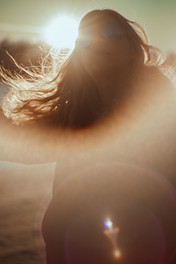Vintage Lenses
- GLASSGLOWZ Media
- Apr 18, 2024
- 4 min read
Updated: Mar 31
Was everything better back then?

It seems like everyone is running to bygone ways and technology. Vinyl is making a comeback, photographers are loading film into their manual SLR cameras, and the mullet is cool. Why is old desirable again? Nostalgia perhaps? A longing for simplicity?
Beats me, but the trend is pushing into camera lenses now.
Modern lenses are just too clean
One explanation I've heard for the popularity rise in vintage glass is that modern lenses are just "too clean". Their perfection lacks character. And this is true. My Canon L series lenses are tack sharp, show little flare, and nail focus nearly every time. So what's the problem with this? It appears that when it comes to art, perfection is boring. Perfection is too close to the real world. We want art to remove us, even for just a moment, from the real world.
And this is where vintage glass shines!
I'm not one for jumping on the latest camera fad bandwagon. However, after seeing a few photos and videos shot on old lenses, I was very intrigued. There was something dreamy and magical with their images that mine seemed to lack.

Super-Multi-Coated Takumar 50mm F1.4
I went digging through my old camera gear, and to my surprise, I actually had a vintage Asahi Pentax lens that I used for macro photography back in my film days! I had picked this lens up at a used camera store back around 2002 after reading about a trick to create a super macro lens by reverse mounting a small wide aperture lens to the end end of your camera lens. By complete luck, I managed to purchase a lens that would be highly sought after for it's unique "vintage" look years later.
The lens was a Super Multi-Coated Takumar 50mm F1.4 built by Asahi for Pentax back in the day. It has a M42 screw mount, manual focus, and thorium lens coatings, which makes it slightly radioactive!
Adapting a vintage lens to a modern camera is really simple these days
Adapting a vintage lens to a modern camera is really simple these days. Just jump on Amazon and you'll find an adapter for pretty much anything. The one I purchased was a Fotodiox M42 to Canon EF adapter for $20.
The pictures this lens renders is simply stunning! At wide open, the background is a beautiful soft swirl. Lens flares are strong, but not completely overpowering. Bright lights will twinkle into magical bokeh balls. Center sharpness is somewhat soft, and the edges gently fade out of focus.
Super-Multi-Coated Takumar Images
Helios 44-2 58mm F2.0
The other lens I have been experimenting with is the Helios 44-2 58mm F2.0. This is by far the most well known and talked about vintage lens on the internet. And to make things even better, a great quantity of them were produced and you can find them for under $100 on ebay right now. Build quality of these lenses vary depending on the factory that produced the unit. The one I purchased came from a low quality factory, so the fit and finish of the focus and aperture rings are not that great. However, image quality remains similar across all factories, so I've read. It also has a M42 screw mount so I was able to use the same adapter to mount this lens to my camera.
The images from the Helios are very similar to the Super Takumar. The background has the same soft swirl patterns. The bokeh balls are beautifully soft. Center sharpness is much better, however, this could be partially caused by the smaller aperture of F2 vs F1.4. One noticeable difference is the intensity of lens flares. Point this lens at the sun and your entire frame is overpowered with the most intense flares I have every experienced! If used wisely, you can create some very dreamy images with the flares.
Helios 44-2 Images
I have to manually focus??!?
Both of these vintage lenses are manual focus, and the aperture is controlled manually as well. Focusing is a challenge, and it's made even more difficult by the fact that modern cameras do not include focusing assistants in the focusing screen plate. What's that you might ask? Let me show you on my old Pentax!
Both of these vintage lenses are manual focus, and the aperture is controlled manually as well.

See that small circle in the middle of the glass with a horizontal line running through it? That's how focusing was performing before autofocus became commonplace. It worked by splitting a small part of the image into two. You turned the focus ring on the lens and when the split image was aligned, you knew you were in focus.
This feature is absent on modern DSLR's and Mirrorless cameras. However, there are other tools to get the job done. If your camera has focus peaking (like my C200), just turn that on and you're good to go. If that isn't an option (like on my 1Dx MK2), then the only other option is to zoom into the image and just judge by eye. This has given me the most accurate focus results to date.
What other lens should I try?
Playing with vintage lenses has opened my eyes to new creative ideas. The act of slowing down to manually focus each image has reminded me how special each photograph truly is, and how fortunate we are to have such sophisticated cameras and lenses compared to what was available in the past.
If you have a special vintage lens you think I should try, leave a comment below!













































コメント